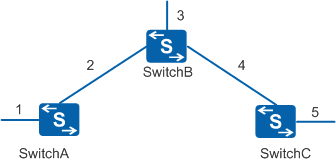Default Static Routes
A default route is a route with the destination IP address set to all 0s. It can be automatically generated using a routing protocol or manually configured. Manually configured default routes are called default static routes. Using default static routes can simplify network configuration. If the destination address of a packet does not match any entries in a router's routing table, the switch forwards the packet along the default route instead.
In Figure 1, if no default static route is configured, static routes destined for networks 3, 4, and 5 must be configured on SwitchA, static routes destined for networks 1 and 5 must be configured on SwitchB, and static routes destined for networks 1, 2, and 3 must be configured on SwitchC. Once all of these static routes are configured, SwitchA, SwitchB, and SwitchC can communicate with each other.
The next hop of packets sent by SwitchA to networks 3, 4, and 5 is SwitchB. Therefore, configuring a single default route on SwitchA can replace the three static routes destined for networks 3, 4, and 5. Similarly, configuring a single default route from SwitchC to SwitchB can replace the three static routes destined for networks 1, 2, and 3.
